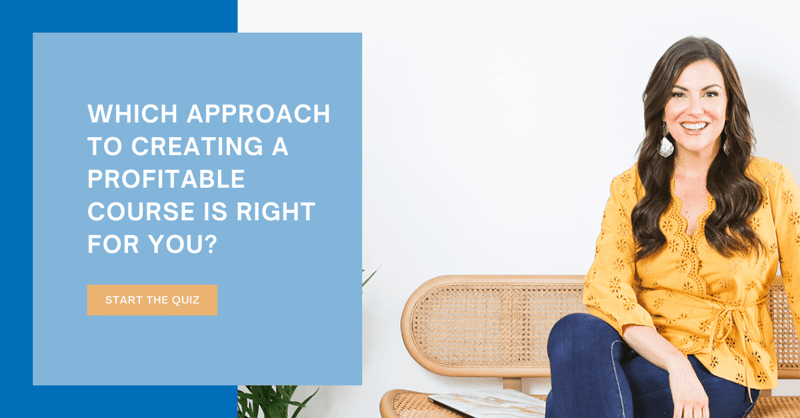Should you create an online training course for your business?
If you're trying to decide on whether to create an online course, this quiz might be a good place to start.
Amy Porterfield and I have partnered up on her Digital Course Academy launch and this quiz is a part of that launch.
So back to the original question: Should you create an online training course?
Over the last few years, I've helped hundreds of business owners grow their businesses using online growth strategies, and at some point, this question comes up.
Should I create an online course?
My answer?
If you're an expert in your field, and you have valuable information to share, I'd say "Yes, you probably should".
But that's a very simplistic answer.
A less simplistic (and more accurate answer) would be ... "It depends".
Not what you want to hear, I know.
But that's the honest truth.
There are several factors that go into deciding whether an online course fits into your broader digital marketing strategy in 2021.
And we'll explore those later in this blog post, but it's safe to say that online courses have worked well for some content entrepreneurs.
Take Len Smith — a copywriter in England — who was contacted by Udemy. He developed a few courses on Udemy and has done very well for himself.
Rob Percival is another example. Rob was a former high school math teacher and decided to try his hand at online courses. It worked well for him. He's replaced his full-time income and then some!
But these successes didn't happen overnight. They took time and effort. It's not what most people want to hear, but it's the truth.
While I don't believe it's possible to build a completely passive income, I do believe that online courses can go a long way towards delivering time freedom to us content entrepreneurs.
Why online courses are a good option for most content entrepreneurs right now
According to the Washington Post, prices of education are rising faster than the financial aid needed to cover those costs.
Meanwhile, the global e-learning market is expected to reach $457.8 billion by 2026.
Based on this, it would be reasonable to infer that e-learning is increasingly becoming a viable alternative to traditional learning approaches taught at universities and colleges.
Because of dramatically improved increased internet speeds, better quality video creation tools (our smartphones that live in our pockets can produce better content than movie studios could produce barely 20 years ago), and a general acceptance of alternative learning modes, online courses are being seen as a viable alternative to traditional learning.

That said, let me be clear about one thing.
I'll say it again because it's so important: Building an online empire doesn't happen with a click of your fingers.
Like most things, it takes time, focused effort, and perseverance.
Ok. So now that we've got that out of the way let's talk about how to go about you can create and launch your online training course.
Decide on your online course topic
What's your course going to be about? Before we answer that question, let's take a step back and a few other really important and related questions.
- Whom do you want to serve? Who's your target audience?
- What transformation do you want to deliver to them?
- Do you have skills or experience around a certain topic that will enable you to deliver insane value to this group of people? (You don't have to be the world's leading expert on the topic but you do have to be a few steps ahead of your audience. More on this later)
If you have experience and/or skills in a certain area that position you as a(n) (relative) expert, and enables you to deliver a meaningful transformation to your target audience, then that's one big tick right there.

And how do you get clear on your target audience? One way to do that is to think about your area of expertise. Most of us have certain skills that we can "productize".
Let's say you're an HR specialist. You could create a course on how to ensure you're compliant with employment legislation.
Or you could create a course on how to recruit high-quality team members through skill-based interviews.
You've built a level of knowledge and expertise in your area of work over the years. That knowledge is highly valuable to your audience (business owners).
The transformation you're delivering to the business owner is from being potentially non-compliant with employee regulation, to having the peace of mind of knowing she's now fully compliant.
And an online course allows you to sell and deliver this transformation at scale.
For the first time in human history, the internet has enabled us to do with the information, what Henry Ford did with cars.
We can turn our knowledge into "products" or information packages aka courses.
And the best part is, this inventory is infinite and can be delivered instantly to any place with an internet connection.
Pretty mind-blowing right?
To get clear on your target audience you might want to consider creating an audience persona.
But don't stop there.
I recommend going one step further and create an empathy map.
An empathy map enables you to really dive into your audience's mind and understand what they're thinking, hearing, feeling, and seeing.
In a recent conversation with Seth Godin, I spoke to him about the importance of empathy in marketing. You might find that conversation interesting.
Ok, so now that you're clear on whom you want to help, let's talk a bit more about how to get clear on the transformation you can (and should) seek to deliver through your online course.
How to decide on what transformation your online course will deliver
What powerful learning outcomes can you deliver to your audience?
Do you have an area of expertise or mastery which puts you in the position to impart knowledge in a meaningful way and help people move forward in their journey?
Maybe you're a business coach who helps businesses grow using digital marketing strategies.
Have you had real-world experience in that area where you've helped a person or a business achieve specific results using digital marketing?
Have you helped that business get from point A (where they were seeking to solve a specific problem — to grow their business using digital marketing strategies) to point B (where they achieved business growth using your strategies)?
If so, you've successfully delivered a transformation.
And that transformation is what your course could deliver to thousands of other business owners (at scale).
Your course will help them bridge that gap between Point A and Point B.

What you need is a framework that helps your prospect get from Point A to Point B. And that's the framework you'll teach in your course.
Ok, so you now have clarity around your target audience, the transformation, and (learning) outcomes you seek to deliver to them.
You have the makings of a good course.
The next step is to establish market demand (before you create the course).
Establish market demand before you create your course via a beta launch
Before you actually create (and launch) your online training course, you need to be sure people are going to actually buy it.
To create a course without having established actual market demand is kinda silly.
Why?
Because you don't want to waste your valuable time creating an awesome course that no one's going to pay for.

This means you need to get comfortable with the idea of selling your course before you actually invest the time in creating it.
This isn't an easy thing to do if you're starting out. But any successful online course creator will tell you this is important.
So how do you approach the market with a course that hasn't been created yet? Do you lie to them and tell them you have a course when you don't.
Nope.
An easy way forward is to do a beta launch.
You explain to your audience that as part of the beta launch you've created a landing page with the curriculum of the course which you'll deliver week by week.
You'll tweak your content based on what resonates with your beta launch group and create something that's super customized and valuable to your beta launch customers.
Your beta launch group helps you build the course.
And as a token of appreciation, you offer them a founding member discount. I did this with my membership program and it worked like gangbusters.
BTW here's a little secret.
You're likely not going to make millions on your first launch. It takes a few launches before you master the art of the launch and understand what works and what doesn't work when selling your course at scale.
Amy Porterfield and I spoke about developing a pre-launch runway at around the 25-minute and 7-second mark of this conversation.
Build the know like and trust relationship with your audience using empathy
You can think of your pre-launch runway as an on-ramp.
It's the 30-60 days leading up to the time you actually sell your digital course.
This is where you get to build a trust-based relationship with your audience.
How do you do this? By showing up regularly and consistently delivering high-value content that solves problems they're seeking to solve (which often lead to a purchase decision). More on this shortly.
Show up on Facebook or Instagram lives once a week and share something of value. Engage with your audience over a series of content-rich episodes that build a bridge from where they are now to where they need to be (for them to be ready to purchase your offer).
Here's the thing: you need to give before you ask for something in return. To borrow a term from Bob Burg, you need to be a go-giver.
That's how you build trust.

You want to think about where your audience is right now and what stops them from being ready to buy right now.
It's those objections you address in the pre-launch runway.
You ask yourself "What does my audience need to believe, to want to buy my online training course?"
Your pre-launch runway is an opportunity to flex those empathy muscles.
It is an opportunity to solve your audience's problems that often (but not always) leads to a purchase decision. It's about creating content that meets your buyer where they are on their journey.
Here's what I mean: check out this washing machine analogy I use in my conversation with Amy at the 28 min and 15-second mark.
There's a lot more that goes into a course launch using webinars, a launch window, affiliate strategies, and so on. We might cover that in more detail in a future blog post but for now, let's name your course.
Choose a memorable course name
I remember speaking to Sonia Simone about naming products. In that conversation, I mentioned that a good title includes the audience, and/or the problem it solves for the audience.
That's a great place to start when it comes to choosing a name for your course.
Take Digital Course Academy for instance.
The title clearly states what the course is about and what you can expect to get from the course.
If you want to go even more niche you might choose to include the audience in the title. For example Digital Course Academy for consultants.
Here's what teachable says you should do when coming up with a name for your course:
-
It should be benefit-driven.
-
It should be specific.
-
It should convey emotion.
Don't get too hung on this though.
Rabbit-hole alert!
It is important to have a good name for your course, but if it stops you from creating your course, it defeats the purpose.
So give yourself a deadline for coming up with the name for your course and move on!
Decide on whether you'll do 'talking head' videos or "screen capture" videos (I recommend video over audio or written course content)
If you're a beginner I recommend doing screen capture videos. There are a ton of moving parts when creating and launching your first course.
You don't want to add the anxiety of being on camera to the list.
Once you get comfortable with all the other aspects of the course creation and launch process you might want to look at creating face to camera content at that point.
However, if you're naturally comfortable being in front of the camera and you've been slaying the Facebook and Instagram lives as part of your pre-launch runway, then the world's your oyster.
Go for it and create all the talking head videos your heart desires!

Either way, get those videos recorded.
I recommend giving yourself short timeframes. That creates a sense of urgency and momentum, both of which help you to get to the finish line faster.
Done beats perfect.
You can always go back and polish things up in future iterations of the course (of which I recommend several if possible).
I have seen courses delivered in written and audio formats, but they're the exception that makes the rule.
Video is by far the most popular (and expected format) when it comes to course delivery.
I recommend sticking to video.
Decide on your price point
Warren Buffett has been quoted as saying "Price is what you pay, value is what you get".
True enough.
But here's the thing.
Value to each person is different.
If my course on productivity helps a lawyer save 2 hours each week and her profit per hour is $500, then that course saves her $1000 each and every week.
What would she be willing to pay for that course? Sure $2000 for the course would be a no-brainer, right?
On the other hand, if I sell that same course to an aspiring (and broke) musician, he's not likely to get as much value out of the course.
Heck, he's not likely to need the productivity gains in the first place, cause he's got all the time in the world!
And his profit per hour is probably close to zero.
How much would he be willing to pay for that same course?
Nada. Zip. Zilch. 
My point?
The price of your course is a much a function of your target market as anything else.
If you're creating a course on productivity for people who earn a high income for every hour they work, and have very little time, then you want to price it at the high end of the market.
If you're creating a course for people who don't have two pennies to rub together ... then maybe you need to have another good look at your target market.
Don't play the price game if you can avoid it. It's a race to the bottom and everyone loses.
Compete on value (for money) as far as possible — not price.
Don't get me wrong. I'm all for giving back to society.
But putting in your efforts into creating a course that caters to the poor and downtrodden that doesn't bring in a reasonable income and doesn't deliver time freedom, is a fool's errand.
If you want to give back to society, you're better off creating a high-priced, profitable course, banking the profits, and donating generously to people who need the money (as a separate exercise).
Decide how long and detailed your course should be
While some people associate more content with high value, most time-poor people prefer content that's direct, actionable, and to the point.
There's a high correlation between affluence and time poverty. Pay attention to that fact.
You could argue that shorter courses command higher prices because they (hopefully) have been carefully curated and customized to the audience.
Fluff-free content wins with the time-poor folk.
Create your course outline (set out the main modules)
Decide on what problem you're solving and for whom.
Hint: It all comes back to understanding your audience, and thinking deeply about the transformation you deliver to that audience.
What is the problem they need to be solved? Where are they now (Point A), and where do you need to get them to (Point B)?

Your course is the bridge between those two points.
Lay out each step they need to take to get from point A to point B and then make sure they follow a logical order.
Record your course lessons within each module
Once you've created the high-level steps then you can drill down further.
I recommend doing this in several sittings because you need to allow the information to 'percolate'. Take regular breaks and draw lots of mindmaps. I find the act of physically writing things down and drawing makes a huge difference.
It creates perspective like nothing else does.
You'll also find yourself refining each module as you create each lesson.
You might realize that a certain lesson belongs in another module and so you move it to that module. You might then decide that it actually belongs in the original module after all. So you move it back.
This is normal. Don't let this put you off. The best thing you can do when you get frustrated (and you probably will from time to time) is to get up and walk away.
Do something else for a while. When you come back to your recording studio you'll probably wonder what all the fuss was about.
Some amount of distance (by taking regular breaks) creates perspective. It allows you to harness the power of the unconscious mind.
Remember that.
Create an irresistible offer (by empathizing with your audience)
To create an irresistible offer you need to have a good understanding of your audience.

Good copywriting is underpinned by a deep understanding of the target market. Develop empathy.
Use tools like Sparktoro to get a better understanding of what your audience actually says and create a sales page that reflects their words.
Build and develop a community for feedback and to add ongoing value
Completion rates on courses tend to be pretty low. I've heard they can be as low as 6 percent.
Something that that seems to be rarely spoken about (but of which I'm a big proponent) is harnessing the power of the tribe when it comes to making your course more impactful.
One way to deliver excellent value to your course takers (and increase the likelihood of completion) is to harness the power of community.

Creating a course and then building an element of community around it where course takers can share ideas and celebrate each other's wins is like adding rocket fuel to a bonfire.
You might want to consider incorporating your course into one of your membership programs. More on this another time.
Conclusion
So there you have it. An ultimate guide to creating and launching your online training course.
There's never been a better time to create an online course. The internet (and accompanying technology) has made it incredibly easy for us to create and consume online courses.
Skyrocketing prices of traditional education (universities and colleges) and the general public's openness towards alternative methods of learning have created the perfect storm.
For the first time in human history, you can productize your knowledge. You can do with your knowledge, what Henry Ford did with cars.
And what's more? Because your product is digital, your inventory costs are close to zero, and you can deliver your product within an instant provided your customer has an internet connection.
Here's my question for you:
Have you thought about creating your own online course? What are you going to create a course about? Let me know in the comments. I'd love to know.
.png?width=284&name=ash-modified%20(1).png)
I LOVE helping heart-centered business owners grow their businesses profitably. I’d LOVE to help you too.
I’ve partnered with my friend, Amy Porterfield, on an amazing initiative. It’ll enable you to share your skills and knowledge with anyone in the world …. and get paid for it
Introducing…. The Digital Course Academy!
Should you launch your own online course? Take this 2-minute quiz here
FREE GUIDE: Create More Freedom & Live Your Best Life: 6 Daily Habits to Swear By > DOWNLOAD IT HERE
The Digital Course Kickstarter: A 30-Day FREE Bootcamp > JOIN NOW
FREE LIVE TRAINING ON FACEBOOK The 7 Most Critical Digital Course Decisions September 7, 2021 at 9am Pacific / 12pm Eastern > JOIN HERE!
Click here to check out these testimonials from people who have achieved success by doing the work, and have created and launched their online courses using Amy’s Digital Course Academy

-1.png?width=300&name=Green%20&%20Pink%20Free%20Challenge%20Event%20Facebook%20Ad%20(1)-1.png)
